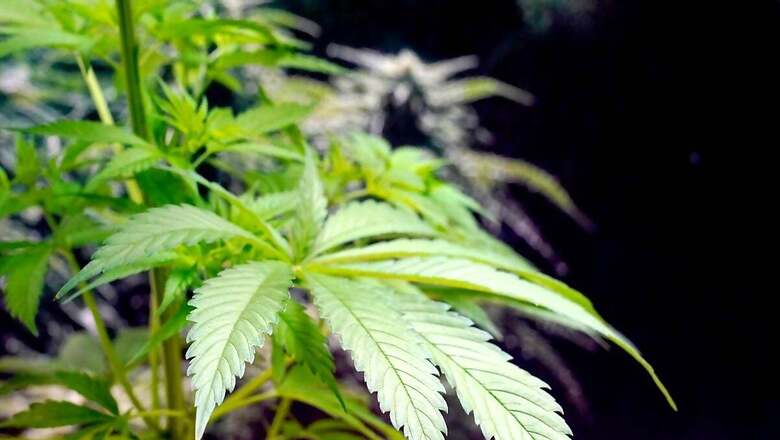
views
The Hindi film song ‘Sheila Ki Jawani’ from the 2010 Bollywood film ‘Tees Maar Khan’ took the world by storm and has garnered more than 200 million views to date. Within another decade, a different kind of Sheila has gained popularity, becoming the craze on campuses, at parties, and get-togethers. This ‘Sheila’ is known as ‘Sheelavathi’, a strain of cannabis that is competing with established world-renowned Indian brands like Malana Cream from Himachal Pradesh and Idukki Gold from Kerala.
Every cannabis plant contains chemical compounds called cannabinoids, with tetrahydrocannabinol being the main psychoactive element. Sheelavathi possesses its own unique set of terpenes and aromatic compounds, setting it apart from other cannabis varieties. The name ‘Sheelavathi’ is that of a tribal Goddess, which has been usurped by this strain of Cannabis.
Grown clandestinely, in the large forested and hilly tracts of the Vizag Agency region, which was called the Vizagapatam Hill Tracts Agency during British rule, this area along with the Andhra-Odisha Border (AOB) cultivates three varieties of cannabis – Raja Hamsa, Kala Pathri and Sheelavathi. The strain called ‘Sheelavathi’ has taken India by storm.
Peddlers from Kerala and Tamil Nadu identified over 11 Mandals that fall in the thickly forested Eastern Ghats, as ideal for the cultivation of the Sheelavathi strain of cannabis. The favourable climatic conditions ensured very handsome returns for the tribal population, with minimum effort compared to other crops and hence has led to the replacement of the region’s traditional crops such as turmeric and ginger.
Around 23 districts in Odisha are also involved in the cultivation of the Sheelavathi strain of cannabis. Thus, over 10,000 acres of land is now being used for cannabis or ganja cultivation. Apart from the local tribals, the police suspect that the Maoists also have a hand in the pie, to finance their illegal activities. The price paid to the tribal farmer hovers around Rs 2,000 per kilo, which shoots up to Rs 10,000 in the metro cities of Hyderabad and Bengaluru. State police and excise officials estimate that the total value of the trade should be approximately Rs 10,000 crore per year. This is supported by the statistics of the seizure of Sheelavathi, which accounts for more than 70 per cent of the 23 lakh kilos of ganja confiscated by the NCB nationwide in recent years. Visakhapatnam, in the process, has earned the reputation of becoming known as the gateway for the Sheelavathi brand of cannabis. This has also led to the setting up of a vast chain of suppliers, dealers, peddlers, and consumers, especially among the student community.
The affordability of Sheelavathi has contributed to its enormous popularity. While Malana Cream commands a high price tag ranging between Rs 5 to 8 lakh for a kilo, Sheelavathi is presently in the affordable price range of just Rs 80,000 to 1.5 lakh per kg. Another important factor that has catapulted Sheelavathi into a bestselling brand is that due to continuous and rigorous enforcement, both Malana Cream and Idukki Gold are hardly available in the market, and therefore remain localised, within their geographical areas.
The utilisation of remote forest tracts for cultivating cannabis has become a common problem in India. Be it Northeast, the Southern states, Kashmir or Chhattisgarh, there is rampant encroachment of forest lands, with the hidden agenda of cultivating cannabis as an easy route to acquiring quick wealth. In the guise of plantations, human settlements, and tourist resorts, encroachment of forest lands is happening at a very rapid pace. Apart from leading to human-animal conflict, the deeper issue of clandestine cannabis cultivation is not being effectively addressed, due to political and religious considerations.
Whether it is Reserved Forests (RFs) or Protected Forests (PFs), human incursions are on rampant rise, motivated by the prospects of making quick money by way of cultivating opium and cannabis.
For example, data released by the Superintendent of Police of the Narcotics and Affairs of Border (NAB), Manipur on May 16, 2023, reveals that poppy plantations on a total of 15,496.8 acres were identified between the 2017-18 fiscal and the 2022-23 fiscal. During this period, 2,518 people were arrested under the Narcotic Drugs and Psychotropic Substances Act, 1985. Poppy plantations on a total of 18,664.5 acres and cannabis plantations on a total of 20 acres were destroyed from 2017 to March 2023.
The problem is that in every state in India, the drive against narcotics and forest encroachment has become enmeshed in politics and religion, making things highly complicated. Any drive against narcotics cultivation is perceived as witch-hunting particular communities and religious denominations.
Further, cannabis production relies on high fertiliser usage to deter browsing by animals. It results in contamination of water, air, and soil with toxic products such as organic pollutants and agrochemicals that damage aquatic wildlife. The high water extraction rates from streams for cannabis irrigation threaten aquatic ecosystems, thereby affecting terrestrial and aquatic biodiversity. Cannabis plants use an average of 22.7 litres per plant per day during the growing season, which typically extends to 150 days. Water use data for cannabis cultivation is virtually non-existent in the published literature, and both published and unpublished sources for this information vary greatly. Management of forest landscapes has become a thorny issue, and the invasion of the markets by new strains like Sheelavathi is a grim pointer that the battle against drugs is a continuous and arduous exercise.
The writer is a retired officer of the IRS and the former director-general of the National Academy of Customs, Indirect Taxes & Narcotics. Views expressed in the above piece are personal and solely that of the author. They do not necessarily reflect News18’s views.




















Comments
0 comment